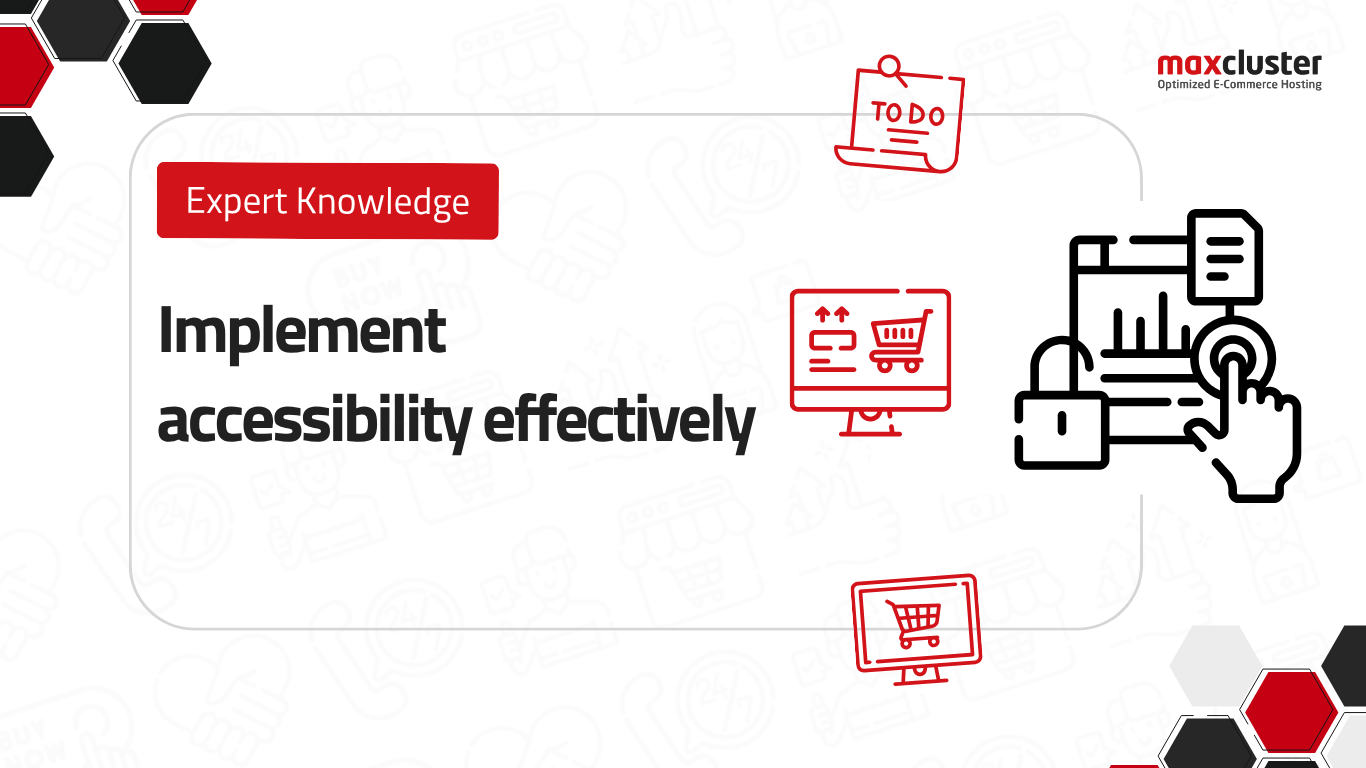
TL;DR – The Essentials in 30 Seconds
Since June 28, 2025, digital accessibility has been legally required for many e-commerce businesses. For online shops, this means:
- Legal obligation: Shops must be accessible – technically, visually, and in terms of content.
- Immediately enforceable: Accessibility applies to all new and existing digital services since June 28, 2025.
- Competitive advantage: Accessibility improves SEO, user experience, and conversion rates.
- Tools & tips: Tools like WAVE, axe DevTools, and Pa11y help you get started.
- maxcluster benefit: Fast, reliable hosting for accessible e-commerce platforms.
In this article, you’ll find the key takeaways from our webinar with AccessiWay – concise and hands-on. You’ll learn what the new digital accessibility law means for you as a shop owner, which deadlines apply, and how to not only meet the legal requirements but also turn them into real value for your business.
What’s included:
- Legal obligations and deadlines
- Practical implementation tips for your online shop
- Recommendations for tools, standards, and hosting
What is the German Accessibility Improvement Act?
Since June 28, 2025, the German Accessibility Improvement Act (BFSG) has been in effect. It transposes EU Directive 2019/882 (European Accessibility Act) into national law. The goal: digital products and services must be designed in a way that makes them accessible to everyone – regardless of limitations such as visual or hearing impairments, motor disabilities, or cognitive challenges.
For you as the operator of an online shop, this means:
Your shop must be accessible – technically, visually, and in terms of content. This includes not only design and color choices, but also navigation, checkout processes, and compatibility with assistive technologies like screen readers.
Further information: German Accessibility Improvement Act
Quick tip: Want to first understand the fundamentals of digital accessibility? Then take a look at this article: Accessibility for Your Online Shop
Why Act Now? The Deadline Is Running Out – And the Pressure Is Growing
The German Accessibility Improvement Act (BFSG) requires many businesses to make their digital offerings – including online shops – accessible. The legal requirements are already in effect, and the pressure to act is high.
Who Is Affected?
The rules apply to all businesses with more than 10 employees or an annual turnover of more than 2 million euros.
This includes in particular:
- Online shops and sales platforms
- Booking portals and digital contract services
- Mobile apps
- Self-service terminals in retail environments
Small businesses with fewer than 10 employees and less than 2 million euros in annual turnover are legally exempt.
However, they can still benefit significantly from accessible offerings – through increased reach, better user experience, and higher revenue. This was emphasized repeatedly during the webinar.
The Most Important Deadlines at a Glance
| Requirement | Deadline | Applies to |
|---|---|---|
| Accessibility as required by the Accessibility Improvement Act | since 28 June 2025 | all providers not explicitly exempted |
| Technical standards (e.g. EN 301 549) | to be implemented immediately | websites, apps, PDFs, contracts |
| Sanctions through market surveillance | active from 28 June 2025 | in case of violations of legal requirements |
What Does Accessibility Mean Specifically in E-Commerce?

Designing for accessibility means investing in the future | Source: Canva
Accessibility in online shops means far more than large fonts or high-contrast colors. It’s about creating a fully accessible user experience – for everyone, regardless of impairments.
The law refers to the European standard EN 301 549, which closely follows the international WCAG 2.1 (Web Content Accessibility Guidelines) – particularly conformance level AA. These requirements are now mandatory.
Four Key Areas to Focus On:
1. Technical Accessibility
- Your website must be compatible with screen readers
- Content must be marked up semantically – e.g., using ARIA roles
- Forms and menus must be fully operable via keyboard navigation
2. Visual and Cognitive Clarity
- Color choices and contrast must be easily recognizable for users with visual impairments
- Text should be easy to understand and well structured
- Buttons, filters, and sliders need clear and unambiguous labels
3. Compatibility with Assistive Technologies
- Support for screen readers, Braille displays, head control systems, and more
- Dynamic elements such as pop-ups or modal windows must not block assistive tools
4. Accessible Media and Content
- Alt text is mandatory for all images and graphics
- Videos must include subtitles or transcripts
- PDFs and embedded documents must be created in an accessible format
Tool tip from the webinar: Use tools like axe DevTools, WAVE, or Pa11y to automatically test your shop for accessibility barriers. These tools help you quickly identify critical issues – without costly audits.
Why Accessibility Is No Longer Just a "Nice-to-Have"
Accessibility isn't a social project—it's a clear competitive advantage in e-commerce. Investing in accessible structures early on not only protects you from sanctions but also increases reach, visibility, and conversion rates.
1. Legal Obligation with Real Consequences
Since June 28, 2025, many businesses are legally required to ensure digital accessibility. Violations now carry immediate consequences.
New websites, apps, and digital services must already be accessible. Existing online shops and digital offerings must be updated accordingly, provided they are still in use or being maintained. Otherwise, the following penalties may apply:
- Fines of up to €100,000
- Legal warnings from competitors or industry associations
- Reputational damage due to negative media or complaints
- Legal disputes with supervisory authorities
Even smaller retailers may be affected if they operate through platforms or marketplaces that fall under the law.
2. Better Visibility in Search Engines
Accessibility and SEO go hand in hand. Content that is readable for screen readers is also easier for search engines to understand. An accessible design provides:
- Structured content and clean code (e.g. HTML5, ARIA)
- Improved readability through clear headings and descriptive links
- Fewer technical errors, which improves crawlability
Example from the webinar:
Shops that implemented WCAG-compliant measures saw significant improvements in their Core Web Vitals and mobile usability – two key ranking factors for Google.
3. Larger Target Group = Higher Revenue
Approximately 15–20% of the population lives with permanent impairments — whether visual, motor, or age-related. Excluding this group means missing out on potential customers. Accessibility is therefore not just a social responsibility, but a clear competitive advantage.
The true market potential is highlighted in a guest article by AccessiWay:
People with disabilities have a combined global purchasing power of around $1.9 trillion. 82% prefer to buy from accessible providers — and many abandon transactions if a website is not accessible.
Accessibility = Revenue Potential:
- Higher conversion rates through clear and simple processes
- Lower bounce rates among mobile and assistive tech users
- Positive user experiences that strengthen brand loyalty
4. Better User Experience for Everyone
What’s accessible for people with impairments often benefits all users:
- Keyboard navigation helps users with temporary limitations
- High contrast improves readability in bright environments, such as sunlight
- Subtitles in videos are helpful in noisy surroundings
The result: Fewer support requests, clearer processes, and more satisfied customers.
Step-by-Step Guide to Creating an Accessible Online Shop
Accessibility isn’t a one-time project you can check off and forget. It’s an ongoing process – and it starts with a clear plan. As emphasized in the webinar: what matters most is not perfection, but a structured approach with documented progress.
1. Start with an Analysis: Where Do You Stand?
- Use tools like WAVE, axe DevTools, or Accessibility Insights to identify initial barriers.
- Conduct an internal audit or bring in a specialized agency for an assessment.
- Document the current state – including the most severe issues and affected components.
Tip: Tools with CI/CD integration, such as Pa11y CI, can be embedded directly into your development pipelines.
2. Set Priorities: What’s Critical?
Not everything has to be perfect right away. Focus first on barriers that significantly limit access:
- Missing alternative text for images
- Forms that cannot be operated via keyboard
- Poor contrast in buttons or navigation elements
- Content that screen readers cannot access
Set clear intermediate goals like: “Make product pages accessible by Q4” or “Screen reader test for checkout by October.”
3. Integrate Accessibility into Your Processes
Accessibility must become a fixed part of your DevOps workflow:
- Include accessibility checks in your build and deployment processes
- Raise awareness across your team with workshops or training – including for editors and designers
- Define clear responsibilities for code, UX, and content
Tools from the webinar: axe DevTools, Pa11y, Lighthouse, WAVE, Siteimprove Accessibility Checker
4. Revise and Rethink Your Content
Many accessibility issues don’t originate in code – but in the content itself:
- Use descriptive link texts instead of “Click here”
- Structure your headings logically (H1–H6)
- Ensure PDFs are created accessibly – with tags, correct reading order, and meaningful ALT texts (for informative images; decorative images can be excluded)
- Add subtitles or transcripts to videos
- Clearly label all interactive elements – e.g. buttons, filters, sliders
5. Communication and Documentation
Transparency builds trust – both internally and externally:
- Document all measures in a clear accessibility strategy
- Include a note on accessibility in your footer or legal notice, along with contact information for reporting issues
- Create a public accessibility statement outlining your current level of compliance and planned improvements
Webinar tip:
Integrate accessibility into your GDPR documentation as well – for example, in contact forms or consent processes.
More information and the full webinar:
maxcluster.de/wissen/events/artikel/accessiway
Why Reliable Hosting Is Essential for Digital Accessibility – and What maxcluster Brings to the Table

Accessibility requires not only good design – but also stable infrastructure | Source: Canva
Accessibility doesn’t end with code and design. Infrastructure also plays a crucial role in determining whether users with disabilities can access your shop without barriers – or not.
Performance Is Part of Accessibility
If your shop loads slowly or is unstable, it creates digital barriers – especially for people who rely on assistive technologies.
Common issues caused by poor infrastructure:
| Problem | Impact on Accessibility |
|---|---|
| Long loading times | Overwhelm and frustration for users with cognitive impairments |
| Time-outs and server errors | Disruption of processes, e.g., during checkout or while completing forms |
| Poor mobile performance | Makes it difficult to use voice control or alternative input methods |
A high-performance hosting environment reduces these risks and creates the technical foundation for true digital inclusion.
More Than Hosting: Why maxcluster Is the Right Foundation for Your Shop
As a hosting provider specialized in e-commerce, maxcluster ensures that your accessible shop remains fast and stable – even under heavy load.
| Feature | Accessibility Benefit |
|---|---|
| Optimized Infrastructure | Fast loading times on all devices |
| 99.99% Availability | No frustration caused by downtime or long loading times |
| Proactive Monitoring | Issues are identified before they become barriers |
| ShopSecurity & Backups | Protection of sensitive user data and reliable recovery |
| 24/7 Support | Fast assistance with scaling questions or technical errors |
Thanks to the combination of technical performance and high security standards, maxcluster is particularly well-suited for shops that take accessibility seriously – including in the context of legal requirements.
Conclusion
Digital accessibility is no longer a topic for the future – it’s a legal requirement and a present-day reality. But it offers much more than just compliance: an accessible online shop improves the user experience for everyone, strengthens trust in your brand, and significantly expands your potential customer base.
Take this opportunity to make your e-commerce platform more inclusive, high-performing, and legally compliant – step by step, with clear priorities and the right tools.
And with infrastructure that supports you reliably along the way.
maxcluster provides the ideal technical foundation: scalable performance, stable availability, and expert advice from e-commerce specialists.
Book a free consultation now: maxcluster.de/schedule-meeting
